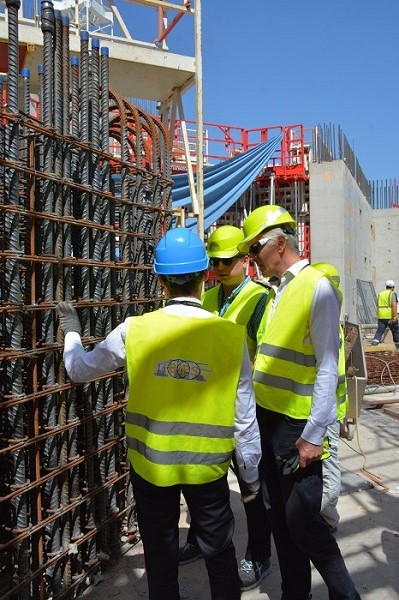Green MEP visits the ITER site


Indrek Tarand, member of the European Parliament, Group of the Greens/European Free Alliance, and Vice-Chair of the Budgetary Control Committee, visited one of the biggest and busiest construction sites in Europe, and witnessed first-hand the significant progress of the ITER project.Before going on the site, the Estonian MEP was provided with a virtual immersion in the ITER machine to understand the scientific foundations and the great promise that fusion energy holds for unlimited, clean, safe and sustainable energy for the future. The scientific and engineering challenges of the ITER project were exposed in plain language while examining every detail of the different components and “feeling” their size and complexity.
The site tour started at the OMEGA consortium, the group of companies which has been entrusted with the management of the final design of the tokamak complex and the supervision of the works on-site. The Green MEP had the opportunity to discuss with the coordinator of the 3D designs for the technical integration of building infrastructures and systems, a maze of pipes and cables carrying anything from high voltage to all sorts of liquids and gases.
The visit continued in the cathedral-high Assembly Hall, where some of the main ITER components will be assembled by special machines before being moved by the 1,500 ton crane to the adjacent Tokamak building for installation. Next stop was at the core of the Tokamak building where the donut-shaped reactor will be placed. The visitors squeezed through the maze of dense steel reinforcements and forms at the 3.5-metre thick and 30-metre high wall of the “bioshield”, which will wrap the ITER device and act as a safety layer between the machine and the building hosting it.

Next on the site tour was the 250-metre long Poloidal Field (PF) coils factory where, due to their impressive diameter and weight, four out of six PF coils of ITER will be manufactured right on site. Following the explanations of the different production stages, the Estonian ex-journaIist was able to see the impressive machinery and tooling used to move objects the size and weight of the PF coils – the largest one being 25 meters high with a weight of 400 tons – with extreme accuracy.
In the afternoon of the visit, ITER IO Director-General Bernard Bigot was able to explain the management and project changes introduced in the last two years which have resulted in the acceleration of the project and in gaining confidence that the 2025 date for the first plasma will be achieved. The visit would have not been complete without presenting the European contribution to the project, the role of industrial partners and fusion laboratories, the benefits for industry and SMEs derived from the innovation and spin-offs generated by these unique business opportunities.
Indrek Tarand thanked F4E for the site visit and the informative discussion which allowed him to gain a new insight into the project: “I have been impressed by the professionalism of the staff that has guided me through this project and by the overall progress and bustling activity on the worksite.”